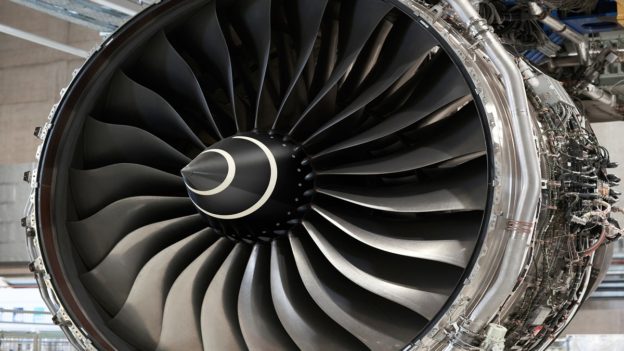A radical breakthrough in Quantum Computing platforms led by NVIDIA, Rolls-Royce and Classiq is going to transform the design and efficiency of the next generation of Jet Engines.
A quantum computing breakthrough is going to bring revolution in design, and efficiency to jet engines.
NVIDIA claims to have brought a radical breakthroughs in Quantum Computing platforms. NVIDIA, Rolls-Royce and Classiq have announced a quantum computing breakthrough for computational fluid dynamics (CFD) used to design jet engines.
For the critical design of a jet engine, it is important to understand how air and gases flow into the engine. This remains the biggest challenge in aerospace engineering as the costs are huge for wind tunnel simulation and testing.
NVIDIA and other partners have designed and simulated the world’s largest quantum computing circuit for computational fluid dynamics — a circuit that measures 10 million layers deep with 39 qubits.
Such breakthroughs are important to Rolls-Royce, a key player in the aviation industry, in its work to build jet engines that support energy transition with more sustainable aviation.
Despite the limitations of today’s quantum computers, which only support circuits a few layers deep, Rolls-Royce is building futuristic quantum tech which is based on graphics processing units (GPUs). Rolls-Royce plans to use the new circuit on its journey to quantum advantage in CFD for modelling the performance of jet engine designs in simulations that use both classical and quantum computing methods.
Quantum for jet engine
So far, the jet engine still remains one of the most complex sciences with an incredible amount of micro parts studded together.
“Designing jet engines, which are one of the most complicated devices on earth, is expensive and computationally challenging,” said Ian Buck, vice president of hyperscale and HPC at NVIDIA.
The quantum computing circuit on NVIDIA’s quantum computing platform could give Rolls-Royce a better perspective while designing its next generation of fuel-efficient jet engines. NVIDIA’s new technologies combine classical and quantum computing in the design of jet engines.
“Applying both classical and quantum computing methods directly to the challenge of designing jet engines will help us accelerate our processes and perform more sophisticated calculations,” said Leigh Lapworth, a computational science fellow at Rolls-Royce.
Rolls-Royce and its partner, Israel-based Classiq, designed the circuit using Classiq’s synthesis engine and then simulated it using NVIDIA’s A100 Tensor Core GPUs.
How did Classiq build around its synthesis engine?
Such advancement was achieved by using NVIDIA’s cuQuantum, a software development kit that includes optimised libraries and tools to speed up quantum computing workflows.
NVIDIA offered a unified computing platform for speeding breakthroughs in quantum research and development across disciplines. The NVIDIA Grace Hopper Superchip, which combines the performance of NVIDIA Hopper architecture GPUs with the versatility of the NVIDIA Grace CPUs, is designed for large-scale quantum simulation workloads.
The method is highly complex with its high-speed interconnect capabilities, which makes classical systems built with the super chip optimally suited to link to quantum processors or QPUs.
Simulating quantum on classical systems is difficult as experts point out.
Here, a strategic bridge to future quantum computing capabilities, Grace Hopper powers DGX Quantum, the world’s first GPU-accelerated quantum computing system combining quantum computing with state-of-the-art classical computing.
The hybrid quantum-classical computing systems are pushing boundaries and are now fully applied to resolve some of the complex problems of designing futuristic, efficient jet engines.
NVIDIA’s lab will also help developers advance the field of quantum computing with tools like CUDA Quantum. Additionally, ORCA Computing is the latest QPU builder to integrate CUDA Quantum, combining its photonic quantum computer with GPUs for machine learning. TensorFlow Quantum and TorchQuantum — two popular quantum machine learning frameworks — now also integrate cuQuantum.
In fact, the company’s invention of the GPU in 1999 sparked the growth of the PC gaming market, redefined computer graphics, ignited the era of modern AI and fuelled the creation of the industrial metaverse.
Breaking boundaries
The breakthrough is opening up a new era for quantum computing. For industries that thought quantum computing had nothing for them, this is opening new applications, as quantum computational physicists predict.
So far, aerospace engineers have relied on wind tunnels and less precise simulations for jet engine design.
With Quantum that is changing fast as Peter Vincent, a professor of computational fluid dynamics at Imperial College London further explained: “When designing turbines, there is a balance to be struck between maximising aerodynamic efficiency, which can reduce with increased blade spacing, and minimising overall weight, which increases with reduced blade spacing.”
“Reducing or eliminating the need for wind-tunnel testing would be a transformational development,” he said.
https://www.financialexpress.com/business/defence-a-quantum-computing-breakthrough-heralds-a-new-era-of-jet-engines-3119729/





